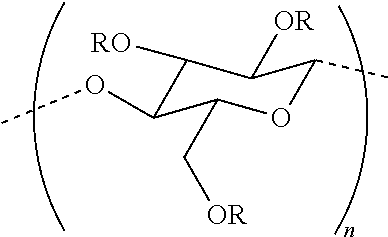Moisture-resistant edible food coating and method for applying the same
a food coating and moisture-resistant technology, applied in confectionery, baking, baking, etc., can solve the problems of insufficient use of edible coatings in baking industry, unappetizing appearance, and inability to meet the needs of consumers, etc., to achieve better freeze/thaw cycle, improve the appearance, and reduce the effect of drying
- Summary
- Abstract
- Description
- Claims
- Application Information
AI Technical Summary
Benefits of technology
Problems solved by technology
Method used
Image
Examples
example 1
[0048]This example demonstrates the effect of the coating on the doughnuts after freezing and thawing. Prior to freezing, select Glazed Yeast Doughnuts and Glazed Old-Fashioned Cake Doughnuts were layered with one of the test coatings formulated with variable types and concentrations of binder (i.e., polysaccharide) and alcohol, as described in Table 7.
TABLE 7TEST COATING COMPOSITIONS (EXAMPLE 1)Test #BinderPlasticizerAlcoholComments1HPCN / AEthyl Alcohol2N / AN / AN / ANEGATIVECONTROL3ECN / AEthyl Alcohol4Confectioner'sAcetylatedEthyl AlcoholGlazeMonoglycerides
[0049]After freezing indefinitely and subsequently thawing for zero hours and for about 3 to 10 hours, respectively, for example, for about 3 to about 8 hours, for about 3 to about 7 hours, for about 4 to about 6 hours, for about 3 to about 6 hours, for about 3 to about 5 hours, for about 4 to about 10 hours, for about 4 to about 9 hours, for about 4 to about 8 hours, for about 4 to about 7 hours, for about 5 to about 10 hours, for abo...
example 2
[0053]This example demonstrates the superior performance of an edible coating with reduced viscosity, as described herein, when applied onto frosted doughnuts using a sprayer. Two formulations of the edible coating were tested. A test coating comprising 3% Hydroxypropylcellulose (HPC) and 97% alcohol of the total of the coating composition was prepared. A test coating comprising 3% Ethyl cellulose (EC) and 97% alcohol of the total of the coating composition was also prepared. Each formulation had a viscosity of about 14 cPs. No plasticizer was used in the HPC or EC coatings.
[0054]In addition, solids of the food coating correspond to the polymeric material of the food coating. For example, a food coating comprising 3% of HPC or EC has a 3% concentration of solids. The viscosity of the food coating described herein is also positively correlated with the concentration of solids comprised within the coating. The more solids comprised in the food coating, the higher the viscosity of the ...
example 3
[0058]This example demonstrates the improved organoleptic qualities of post-thawed, frosted doughnuts (i.e., Glazed Old-Fashioned Cake Doughnuts and Chocolate-Frosted Yeast Doughnuts) when sprayed with an edible food coating of the present invention prior to freezing. The instant food coating may or may not contain plasticizer. After spraying select doughnuts with the HPC coating without plasticizer or not at all (negative control) as described in Example 2, the doughnuts were further tested for appearance and taste qualities via a sensory evaluation.
[0059]The HPC-coated and the uncoated Control doughnuts undergoing the sensory evaluation were quick frozen in a blast or quick freezer for about 15 to about 45 minutes, then packaged and held for 2 weeks in a static freezer having temperatures ranging from about −10° C. to about −20° C. and an 80% relative humidity. The doughnuts were then thawed and tested at zero (0) hours, five (5) hours, and 22 hours in a holding room having ambien...
PUM
 Login to View More
Login to View More Abstract
Description
Claims
Application Information
 Login to View More
Login to View More - R&D
- Intellectual Property
- Life Sciences
- Materials
- Tech Scout
- Unparalleled Data Quality
- Higher Quality Content
- 60% Fewer Hallucinations
Browse by: Latest US Patents, China's latest patents, Technical Efficacy Thesaurus, Application Domain, Technology Topic, Popular Technical Reports.
© 2025 PatSnap. All rights reserved.Legal|Privacy policy|Modern Slavery Act Transparency Statement|Sitemap|About US| Contact US: help@patsnap.com

